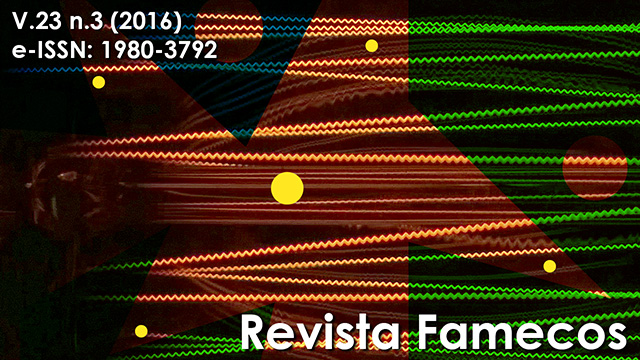Journalists and tecnoactors: the negotiation between professional cultures whitin on-line newsrooms
DOI:
https://doi.org/10.15448/1980-3729.2016.3.24292Keywords:
Online journalism, Tecnoactors, Professional cultureAbstract
This paper observes the growing influence of designers and programmers in the journalistic work within online newsrooms. Described as “tecnoactors”, these professionals acquire visibilityby mastering professional expertise, decisive in the production of news. The purpose here is to investigate how journalists, designers and programmers establish negotiations during production routines. The empirical study is delimited to six online newsrooms – three from Brazil and three from Portugal –where 17 semi-structured interviews with members of the professional categories were made. The qualitative analysis focus onfour themes: 1) negotiation processes; 2) news concept; 3) physical distance versus epistemic distance; 4) professional hybridity.Downloads
References
ANANNY, Mike. Press-Public collaboration as infrastructure: Tracing news organizations and programming publics in application programming interfaces. American Behavioral Scientist, v. 57, n. 5, p. 623-642, 2012. DOI: 10.1177/0002764212469363.
ANANNY, Mike; CRAWFORD, Kate. A Liminal Press: Situating news app designers within a field of networked news production. Digital Journalism, v. 3, n. 2, p. 192-208, 2015. DOI: 10.1080/21670811.2014.922322.
ANDERSON, Christopher W. Towards a sociology of computational and algorithmic journalism. New Media & Society, v. 15, n. 7, p. 1005-1021, 2013. DOI: 0.1177/1461444812465137.
BARBOSA, Suzana Oliveira; TORRES, Vitor. O paradigma “Jornalismo Digital em Base de Dados”: modos de narrar, formatos e visualização para conteúdos. Galáxia. Revista do Programa de Pós-Graduação em Comunicação e Semiótica da PUCSP, v. 25, p. 152-164, 2013.
BELL, Emily. It’s time we fought back. British Journalism Review, v. 26, n. 1, p. 34-41, 2015. DOI: 10.1177/0956474815575453.
BREED, Warren. Social control in the newsroom: A functional analysis. Social Forces, v. 33, n. 4, p. 326-335, maio 1955. DOI: 10.2307/2573002.
CANAVILHAS, João, SATUF, Ivan, LUNA, Diógenes, TORRES, Vitor. Jornalistas e tecnoatores: dois mundos, duas culturas, um objetivo. Esferas, v. 3, n. 5, 2014.
CARLSON, M. (2015). Introduction: The many boundaries of journalism. In: CARLSON, Matt; LEWIS, Seth C. (ed.). Boundaries of journalism: Professionalism, practices and participation. Routledge, 2015.
CHARRON, Jean; DAMIAN-GAILLARD, Béatrice; TRAVANCAS, Isabel. Journalism’s “Invisibles”. Introduction. Sur le journalism About journalism Sobre jornalismo, v. 3, n. 1, p. 10-13, 2014.
COHEN, Sarah; HAMILTON, James T.; TURNER, Fred. Computational journalism: how computer scientists can empower journalists, democracy’s watchdogs, in the production of news in the publict interest. Communications of the ACM, v. 54, n. 10, p. 66–71, 2011. DOI: 10.1145/2001269.2001288.
ERICSON, Richard Victor; BARANEK, Patricia M.; CHAN, Janet .Visualizing deviance: A study of news organization. Toronto: University of Toronto, 1987.
GANS, Herbert J. Deciding what’s news: A study of CBS evening news, NBC nightly news, Newsweek, and Time. New York: Random House, 1979.
GARRISON, Bruce. Computer-assisted reporting near complete adoption.Newspaper Research Journal, v. 22, n. 1, p. 65–79, 2001.
KOVACH, Bill; ROSENSTIEL, Tom. Blur: How to know what’s true in the age of information overload. New York: Bloomsbury Publishing, 2011.
MANOVICH, Lev. The language of new media. Cambridge: MIT press, 2001.
MANOVICH, Lev. Software takes command: extending the language of new media. New York: Bloombury, 2013.
MERRIN, William. Media Studies 2.0. Abingdon: Routledge, 2014.
NIELSEN, RasmusKleis. How newspapers began to blog: Recognizing the role of technologists in old media organizations’ development of new media technologies. Information, Communication & Society, v. 15, n. 6, p. 959-978, 2012.
PARASIE, Sylvain; DAGIRAL, Eric.Data-driven journalism and the public good: “Computer-assisted-reporters” and “programmer-journalists” in Chicago. New Media & Society, v. 15, n. 6, p. 853–871, 2012. DOI: 1461444812463345.
PAVLIK, John. The impact of technology on journalism. Journalism Studies, v. 1, n. 2, p. 229-237, 2000.
QUADROS, Claudia; CAETANO, Kati; LARANGEIRA, Álvaro. Jornalismo e Convergência: Ensino e práticas profissionais. Covilhã: LabCom Books, 2011.
ROBINSON, Sue. Convergence crises: News work and news space in the digitally transforming newsroom. Journal of Communication, v. 61, n. 6, p. 1122-1141, 2011.
ROYAL, Cindy. The journalist as programmer: A case study of the New York Times interactive news technology department. In: InternationalSymposiumon Online Journalism. v. 2, n. 1, p. 5-24, 2012.
TRÄSEL, Marcelo. Aprendendo a se deixar guiar por dados: a formação dos jornalistas da equipe Estadão Dados. REBEJ - Revista Brasileira de Ensino de Jornalismo, v. 4, n. 14, p. 85-99, 2014.
TUCHMAN, Gaye. Making news: A study in the construction of reality. New York: The Free Press, 1978.
WESTLUND, Oscar. Producer-centric versus participation-centric: On the shaping of mobile media. Northern Lights: Film & Media Studies Yearbook, v. 10, n. 1, p. 107-121, 2012.
ZELIZER, Barbie. Taking journalism seriously: News and the academy. Thousand Oaks: Sage Publications, 2004.
Published
How to Cite
Issue
Section
License
Copyright
The submission of originals to Revista Famecos implies the transfer by the authors of the right for publication. Authors retain copyright and grant the journal right of first publication. If the authors wish to include the same data into another publication, they must cite Revista Famecos as the site of original publication.
Creative Commons License
Except where otherwise specified, material published in this journal is licensed under a Creative Commons Attribution 4.0 International license, which allows unrestricted use, distribution and reproduction in any medium, provided the original publication is correctly cited.






